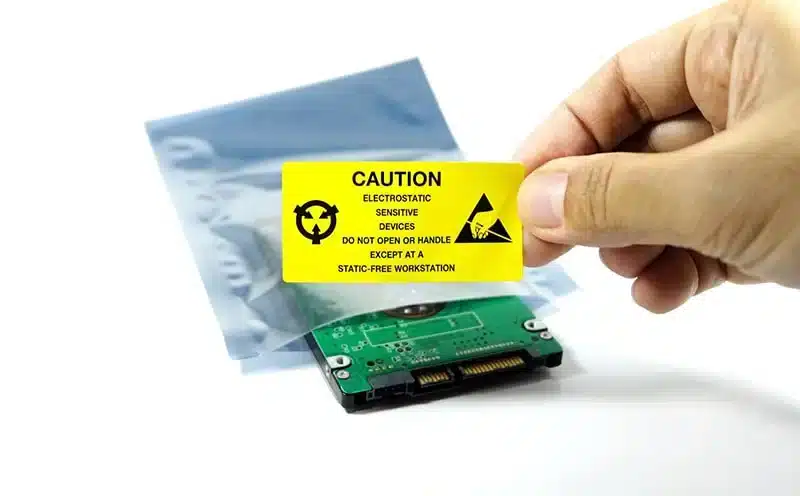Why Static-Shielding Packaging is important for Electronics?

In the rapid evolution of electronic technology, electronic devices have transitioned from luxuries to daily necessities, permeating every aspect of life, from smart homes to medical equipment. The internal components of these devices—such as microprocessors and sensors—continue to miniaturize and integrate at higher levels. This relentless drive results in extremely fragile physical structures that are highly sensitive to environmental disturbances.
Even minor electrostatic accumulation during routine handling in manufacturing, transportation, and storage can inadvertently trigger irreversible performance degradation. This vulnerability necessitates robust protection strategies.
Static-shielding packaging emerges as the critical solution. It utilizes specialized materials like metallized films or conductive coatings to create a continuous shielding layer. This layer effectively isolates the enclosed components from external electrostatic fields and prevents dangerous charge buildup on the sensitive items themselves.
The function of this packaging extends far beyond simple component protection. It safeguards the integrity of electronic components and underpins the reliability of complex global supply chains. For instance, in semiconductor factories, chips undergo numerous delicate processes before final encapsulation. Static-shielding bags are indispensable, ensuring components remain safe from potential electrostatic discharge (ESD) damage throughout their journey from the production line to the end-user.
The direct impact is significant: reduced scrap rates and lower rework costs. Industry reports consistently highlight that ESD-related damage causes billions of dollars in annual losses for the electronics sector. Effective packaging is a frontline defense against this costly threat.
The design principle of static-shielding packaging leverages the fundamental Faraday cage effect. Conductive materials form an enclosed barrier that creates a protective zone, effectively isolating anything inside from external electric fields. This principle is powerful and scalable.
It applies not only to protecting tiny individual parts like IC chips but also extends robustly to the transportation packaging of entire finished devices, such as servers, smartphones, or medical equipment. The need for this protection is recognized and mandated.
Industry standards, such as ANSI/ESD S20.20, explicitly require the use of static-shielding packaging for sensitive electronics. This ensures products consistently meet stringent international quality and safety certifications. Logistics companies heavily rely on solutions like static-shielding boxes and bags.
These specialized containers are essential for shipping high-value electronics globally. They minimize the electrostatic risks inherent during transit, which can arise from factors like vibration-induced friction, package handling, or shifts in humidity levels. The benefits also positively impact the end-user experience.
Consumers unboxing a new device expect flawless operation. Static-shielding packaging plays a vital, though often unseen, role in ensuring no unexpected malfunctions occur right out of the box. This reliability directly translates to enhanced customer satisfaction and stronger brand trust.
From an economic standpoint, investing in static-shielding packaging involves an initial cost increase. However, this investment yields substantial long-term savings. It effectively averts far more expensive downstream costs associated with warranty repairs, product recalls, customer compensation, and significant reputational damage.
Consider automotive electronics: a modern car contains numerous critical Electronic Control Units (ECUs). If even one ECU is damaged by ESD during transport or storage, it could necessitate a costly and disruptive full vehicle recall. Static-shielding packaging is a crucial risk mitigation strategy in such high-stakes scenarios.
Furthermore, static-shielding packaging contributes meaningfully to sustainability goals within the electronics industry. By effectively protecting components from ESD damage during their lifecycle stages, it directly extends their functional lifespan. This reduces the volume of electronic waste generated by premature failures and obsolescence, aligning strongly with circular economy principles.
Material innovations are also driving greener solutions. The development and adoption of recyclable conductive polymers for static-shielding bags and wraps are actively reducing the environmental footprint of this essential protective packaging. Globalization adds another layer of complexity.
Supply chains now span continents, exposing sensitive electronics to diverse and often harsh climatic conditions during transit. Static-shielding packaging provides a critical buffer. It ensures stable protection for components journeying from factories in Asia to distribution centers in Europe or America, effectively preventing electrostatic events triggered by temperature swings and humidity fluctuations.
Looking towards the future, the challenge intensifies. The proliferation of Internet of Things (IoT) devices and 5G technology demands even smaller, more densely packed, and consequently, more ESD-sensitive electronic components. The sensitivity of future electronics will only increase.
This necessitates parallel innovation in static protection. Intelligent upgrades to static-shielding packaging are on the horizon. Concepts like integrating sensors to continuously monitor internal electrostatic levels or environmental conditions within the package represent promising trends. Such advancements will inject new vitality and capabilities into the electronics protection landscape.
In conclusion, static-shielding packaging is far more than just a bag or a box; it is an indispensable cornerstone of the entire modern electronic ecosystem. Its role transcends mere physical protection. It is fundamentally intertwined with operational efficiency across global supply chains, rigorous compliance with international standards, and the ongoing drive for technological innovation. Without the silent vigilance of effective static-shielding packaging, the relentless progress and stability of our electronic civilization would face constant, significant jeopardy.
